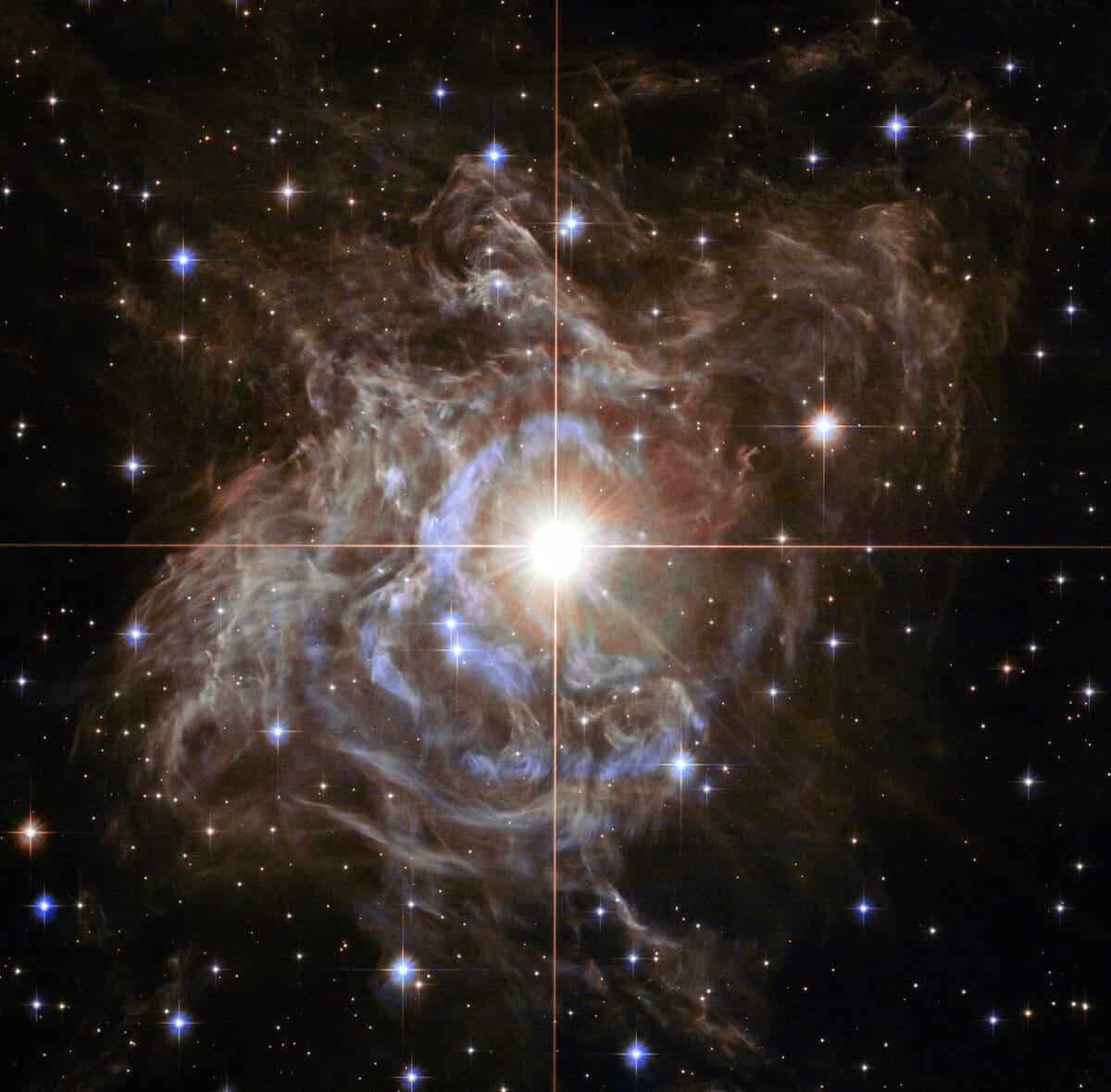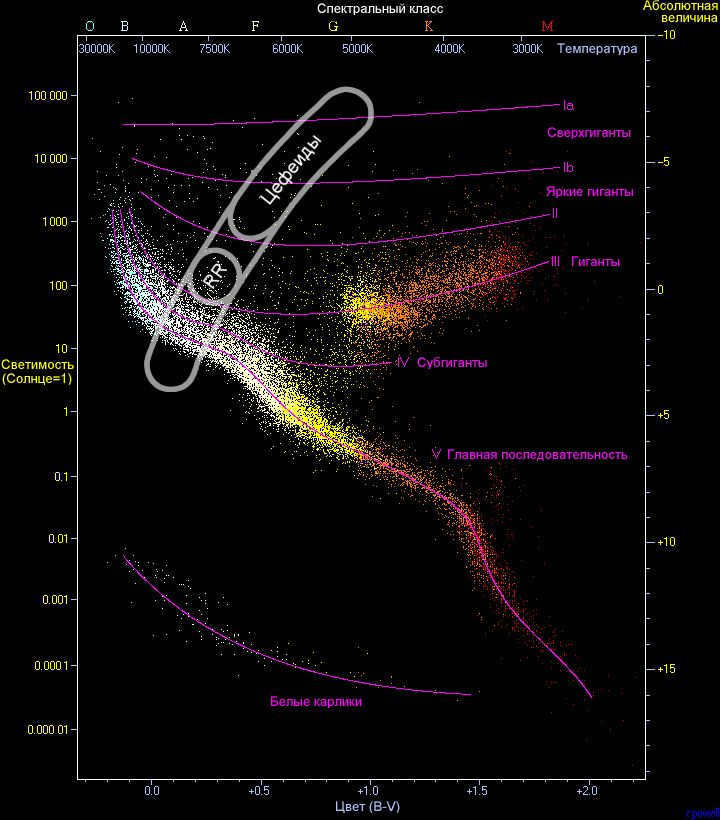
A Cepheid star is a specific type of star that fluctuates in brightness, pulsating in a radial manner and simultaneously altering its size and temperature. In this scenario, the luminosity of the star varies consistently over a defined period and by a specific degree.
Cepheids play a crucial role in determining distances within galaxies and between galaxies as they serve as important reference points in the cosmic landscape. The reason for this is the existence of a clear and direct correlation between the luminosity of a variable Cepheid and its pulsation period. By knowing the intrinsic brightness of a Cepheid, it is possible to calculate its distance because the brightness follows the inverse square law. Consequently, Cepheids are commonly referred to as “standard candles”.
On September 10, 1784, the British astronomer Edward Pigott made the groundbreaking discovery that the triple star Eta Eagle exhibits changes in its brightness. This discovery marked the identification of the first classical variable Cepheid. A few months later, the amateur astronomer John Goodrick from England identified another variable star, which led to the naming of this class of stars as Delta Cepheus. By the end of the 19th century, the number of known variable stars of this kind had increased to several dozen, and they became collectively known as Cepheids. Most Cepheids were distinguished by their characteristic light curve patterns, featuring a rapid increase in brightness followed by a hump in the graph. Some stars with more symmetrical light curves were named Geminids after the prototype, Zeta Gemini.
In 1908, Henrietta Swann Livitt made a groundbreaking discovery while studying numerous variable stars in the Magellanic Clouds at the Harvard College Observatory. As an assistant to astronomy professor Edward Charles Pickering, Livitt also worked as a calculator. Her findings, which she published in 1912 along with additional evidence, revealed a correlation between the period and luminosity of classical Cepheids. It was observed that these Cepheid variables exhibited a change in radial velocity that corresponded to their changes in luminosity. Initially, this led to the belief that these stars were part of a binary system. However, in 1914, Harlow Shapley disproved this hypothesis. Two years later, Shepley and other researchers discovered that Cepheid variables undergo changes in their spectral types throughout a cycle.
In 1913, Einar Herzsprung made an attempt to calculate the distances to 13 Cepheids by observing their movement across the sky (however, his findings later had to be corrected). In 1918, Harlow Shapley used the Cepheids to establish initial limitations on the size and shape of the Milky Way and the Sun’s position within it. In 1924, Edwin Hubble determined the distance to the classical variable Cepheids located in the Andromeda Galaxy, previously referred to as the Andromeda Nebula, and demonstrated that these variable stars exist outside of the Milky Way. Hubble’s discoveries resolved the question raised in the Great Debate regarding whether the Milky Way encompassed the entire universe or if it was merely one of many galaxies in the universe.
During the mid-20th century, the astronomical distance scale faced significant challenges, which were eventually overcome by categorizing Cepheids into distinct classes with unique characteristics. In the 1940s, Walter Baade made a groundbreaking observation that there were two distinct populations of Cepheids: classical and type II. Classical Cepheids belong to the younger and more massive population I stars, while Type II Cepheids are older and dimmer, belonging to population II. These two classes differ in their period-luminosity relationships.
Type II Cepheids, on average, have a luminosity about 1.5 stellar magnitudes lower than classical Cepheids. Baade’s pivotal discovery led to a doubling of the estimated distance to M31 and revolutionized the extragalactic distance scale as a whole.
The commonly accepted explanation for the pulsating mechanism of Cepheids is known as the Eddington valve, or the “κ-mechanism,” where the Greek letter κ (kappa) represents the gas’s opacity. The primary driving force behind this process is believed to be helium. Helium that has been ionized twice (meaning it is missing both electrons) is more opaque than helium that has been ionized once. As the amount of helium increases, it becomes more ionized. During the least bright phase of the Cepheid cycle, the ionized gas in the star’s outer layers is opaque and is therefore heated by the star’s radiation, causing it to expand as the temperature rises. As the gas expands, it cools down and becomes less ionized, meaning it becomes more transparent and allows radiation to escape. The expansion then halts, and the star’s gravitational pull causes the gas to contract. This process then repeats.
Wormholes Explained
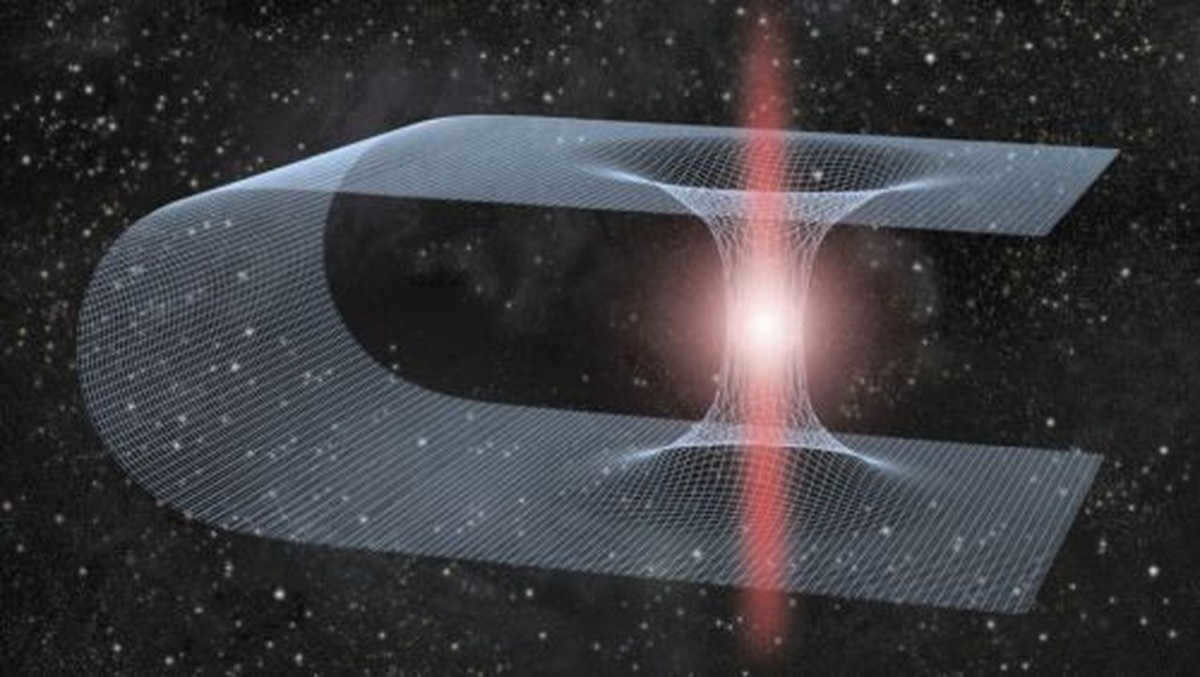
A wormhole is a theoretical passage that connects distant points in space-time. The concept of a wormhole can be derived from a unique solution to Einstein’s field equations.
Wormholes are consistent with the principles of general relativity, although their actual existence remains unknown. Many scientists hypothesize that wormholes may be manifestations of a fourth spatial dimension that is beyond our perception – similar to how two-dimensional beings can only perceive slices of three-dimensional objects.
In 1995, Matt Visser proposed the idea that there could be multiple wormholes in the universe if cosmic strings with negative mass originated in the early stages of the universe. Some physicists, including Kip Thorne, have even proposed methods for artificially creating wormholes.
Wormholes in the Schwarzschild Metric
The initial type of wormhole discovered (in theory) was the Schwarzschild wormhole found in the Schwarzschild metric that describes an everlasting black hole. However, calculations indicated that it was collapsing too rapidly to permit travel through it from one end to the other. It was proposed that wormholes, which allow for passage in both directions (traversable), could only be feasible if exotic matter with negative energy density was employed to stabilize them. However, physicists subsequently revealed that microscopic traversable wormholes are achievable without the need for exotic matter. Instead, they require fermionic matter with an electric charge and a sufficiently small mass to prevent it from collapsing into a charged black hole.
If such wormholes are indeed possible, their capabilities may be limited, for instance, to the transmission of information only. However, it is also possible that wormholes exist that can be crossed by humans, especially if our reality is described by the second Randall-Sundrum model, a theory that incorporates branes.
Einstein-Rosen bridges
Schwarzschild wormholes, also referred to as Einstein-Rosen bridges, are connections between different regions of space that occur in vacuum solutions to Einstein’s field equations. In accordance with contemporary concepts, they are an essential component of the fully extended version of the Schwarzschild metric, which describes an eternal black hole without charge and rotation. When we talk about “maximal extensibility” here, we are referring to the notion that spacetime has no “boundaries”: any possible trajectory of a freely falling particle (following a geodesic curve in spacetime) can be continued indefinitely into both the future and the past of the particle.
To fulfill this condition, aside from the internal area of the black hole where particles plunge while passing the event horizon, there needs to exist a distinct inner region of the “white hole” that permits us to infer the paths of particles that an external observer perceives ascending from the event horizon.
The discovery of the Einstein-Rosen bridge is credited to Ludwig Flamm in 1916, shortly after Schwarzschild’s solution was published. It was later independently rediscovered by Albert Einstein and his colleague Nathan Rosen, who published their findings in 1935. However, in 1962, John Archibald Wheeler and Robert W. Fuller presented a paper demonstrating that this particular type of wormhole is inherently unstable when connecting two regions within the same universe. They showed that it would contract too rapidly for any particle, including light, to traverse from one region of spacetime to the other.
While Schwarzschild wormholes cannot be traversed in either direction, they served as inspiration for Kip Thorne to envision passable wormholes that could be created by opening the “throat” of a Schwarzschild wormhole with exotic matter possessing negative mass/energy.
Traversable wormholes
Based on the Casimir effect, quantum field theory suggests that certain regions of space can have negative energy density compared to the usual vacuum energy of matter. Theoretical studies have shown that quantum field theory allows for states where energy can be arbitrarily negative at a specific point. Many physicists, including Stephen Hawking and Kip Thorne, have proposed that these effects could potentially stabilize a traversable wormhole.
In the realm of general relativity and quantum mechanics, Leonard Susskind introduced the ER = EPR hypothesis, which is the only known natural process that offers a potential explanation for the creation of wormholes. Another hypothesis, known as the quantum foam hypothesis, suggests that wormholes can spontaneously manifest and disappear on a minuscule scale known as the Planck scale. Some scientists have proposed the existence of stable wormholes as potential candidates for dark matter. Additionally, there is speculation that a tiny wormhole, kept open by a cosmic string with negative mass, may have emerged during the Big Bang and expanded to a macroscopic size due to cosmic inflation.
Lorentzian passable wormholes offer the potential for rapid travel between different parts of the same Universe or even between different Universes. The concept of passable wormholes within the framework of general relativity was initially demonstrated in a 1973 paper by Homer Ellis, and independently in a paper by K. A. Bronnikov in the same year.
In 1988, Kip Thorne and his graduate student Mike Morris independently discovered the theoretical possibility of Ellis wormholes and suggested their use as a teaching tool for general relativity theory. Consequently, the specific type of passable wormhole they proposed, which is kept open by an open spherical shell of exotic matter, is also referred to as a Morris-Thorne wormhole.
Additional types of traversable wormholes were subsequently uncovered as permissible solutions to the equations of general relativity, including the variant examined in Matt Visser’s 1989 article, which proposes a route through a wormhole that avoids passing through a region of exotic matter.
Wormholes for temporal displacement
Wormholes link two points in spacetime, thereby enabling both temporal and spatial travel. In 1988, Morris, Thorne, and Yurtsever discovered a method to convert a wormhole’s movement from spatial to temporal by accelerating one of its two entrances.
Consequently, when someone enters the “younger” side of the wormhole, they will emerge from the “older” side at the precise moment when the age of the older side matches the age of the younger side. This effectively allows them to travel back in time, as observed by an external observer. However, there is a major limitation to this type of time machine: it can only transport individuals back to the moment when the machine was originally created. In essence, it is a form of time travel rather than a device that moves backwards through time. Nevertheless, this method of travel can still give rise to time paradoxes.
One possible resolution to the paradoxes that emerge from traveling through wormholes in time is rooted in the concept of the many-worlds interpretation of quantum mechanics. According to some theories, individuals who successfully traverse a “time wormhole” would not end up in the past of their own universe, but rather in a parallel universe.
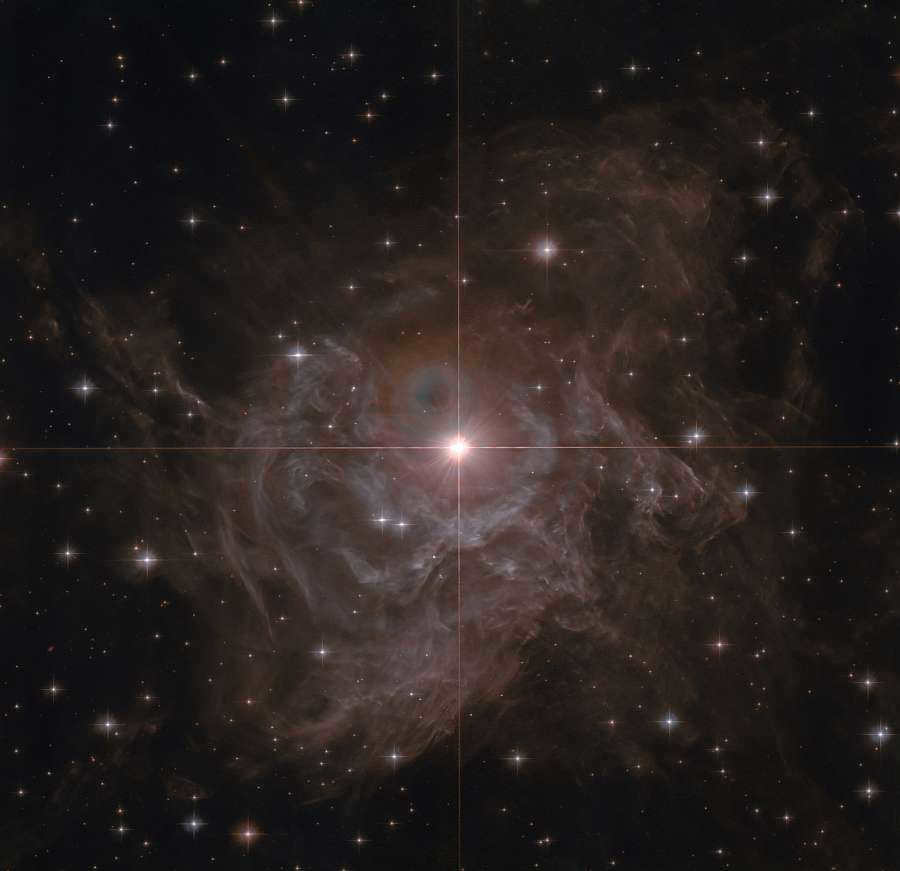
Cepheids are often referred to as the guiding lights of the cosmos, as they provide a reliable method for determining the distance to faraway celestial bodies.
Stars that change
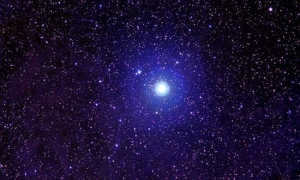
Polaris is an example of a classical Cepheid star.
Cepheids are a unique group of regular variable stars. Polaris, in particular, is well-known for its role as a navigational aid, guiding lost travelers by indicating the direction of the north in the northern hemisphere.
Variable stars earned their name due to their perceptible fluctuations in brightness. These stars, much like the twinkling lights of a Christmas garland, appear to blink from the far reaches of galaxies. The variability in their brightness is a result of various physical processes occurring within these celestial bodies. Astronomers commonly refer to this phenomenon as the nature of Cepheid Variability.

As previously mentioned, astronomers have not yet fully understood the various natural physical processes that cause the blinking or pulsation of Cepheids.
Additional Resources
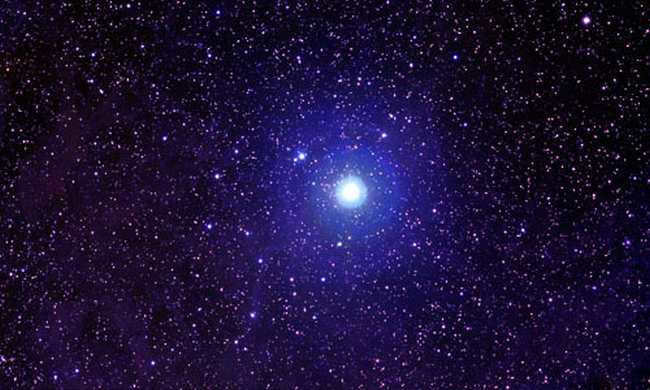
The main idea behind these processes is that the gas pressure and gravity in the upper layers of stars are disrupted, causing the star’s radius to periodically shrink. This shrinking is observed as pulsation.
The compression of the star’s radius directly impacts its surface temperature. For instance, a 15% reduction in the radius of a Cepheid star can lead to a temperature increase of over 1000 degrees Kelvin.
In addition to the change in radius, the star’s luminosity also varies. When the radius is at its minimum, the star emits the maximum amount of light, and as the radius increases, the amount of emitted light decreases.
The Etymology of the Name
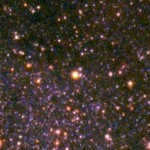
The term Cepheids is coined after the Delta Cephei star with the same name. The brightness of this particular celestial object changes every five days, fluctuating between 3.6 to 4.3 magnitudes.
Cepheids are typically giants and supergiants that fall within the F and G spectral classes. These stars are thousands of times more luminous than our Sun, although this is not always directly proportional to their mass. For instance, there are Cepheids with a mass only a quarter of that of our Sun. On the other hand, there are giants among them whose mass exceeds that of our star by a factor of forty. Many Cepheids are binary stars, but there are also single Cepheids that exhibit a similarly high level of luminosity.
Classification of Cepheids
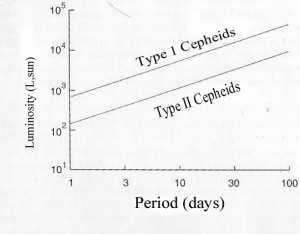
There are two types of Cepheids that astronomers distinguish: population I Cepheids and population II Cepheids. Population I Cepheids are typically found in scattered star clusters and are known for their relatively young age. These Cepheids are often referred to as classical Cepheids.
On the other hand, population II Cepheids, like W Virgo, are primarily found in globular clusters near the galactic center. These Cepheids have a higher age compared to population I stars and exhibit noticeably lower luminosity.
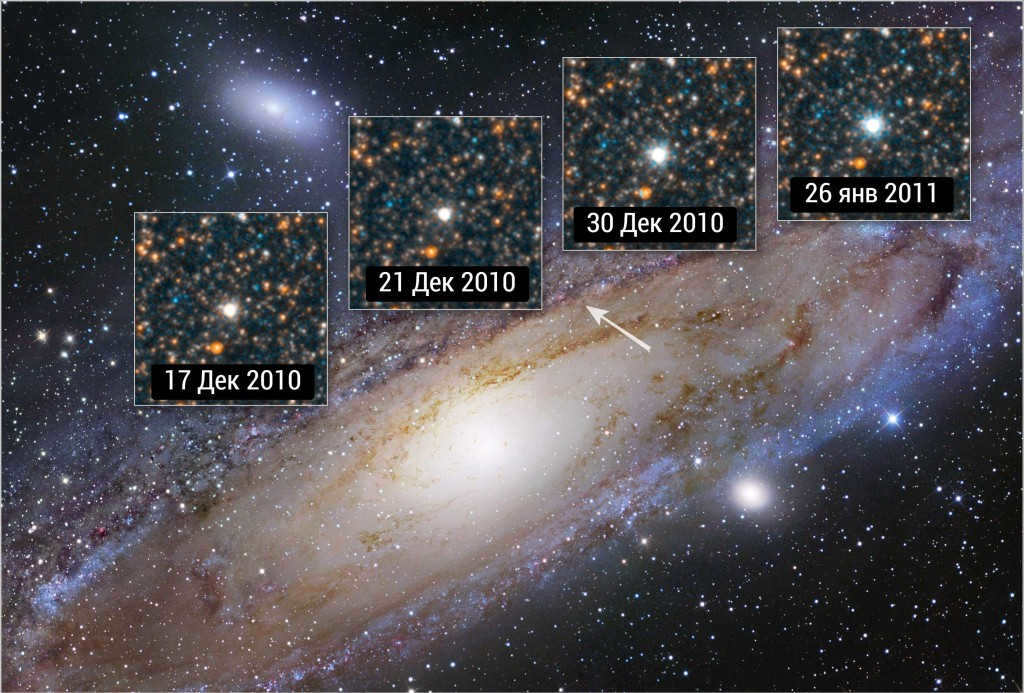
Variation in the brightness of the star V1 in the galaxy M31
Astronomers refer to Cepheids as the guiding lights of the Universe. This is due to the fact that these celestial entities enable us to determine the distance to remote cosmic objects, particularly galaxies. The process is as follows. Let’s assume that you have detected a Cepheid in another galaxy. The initial step is to calculate its pulsation period, which allows you to measure the brightness of the star. By comparing this value with its apparent brightness, you can determine the distance to the star, as well as to the galaxy in which it was discovered.
Interesting facts
- The brightness of Cepheids is directly proportional to their pulsation period: the longer the period, the brighter the star;
- The majority of Cepheids are visible to the naked eye. A large number of them are located over 60 million light years away from Earth;
- Delta Cepheus was the first type of variable star discovered by astronomers. The class of stars described above was named after her.
What information should individuals unfamiliar with this constellation acquire? Accordingly, Cepheus is a constellation located near the pole in the Northern Hemisphere of the celestial sphere.
The legendary ruler of the celestial expanse
The configuration of the Cepheus constellation somewhat resembles an irregular pentagon. Visualizing it becomes even simpler if you draw a house with a roof (consisting of a square and triangle) on a sheet of paper, similar to how we did in our childhood. By flipping it over, a comparable image can easily be identified in the night sky.
When and where to view the Cepheus constellation
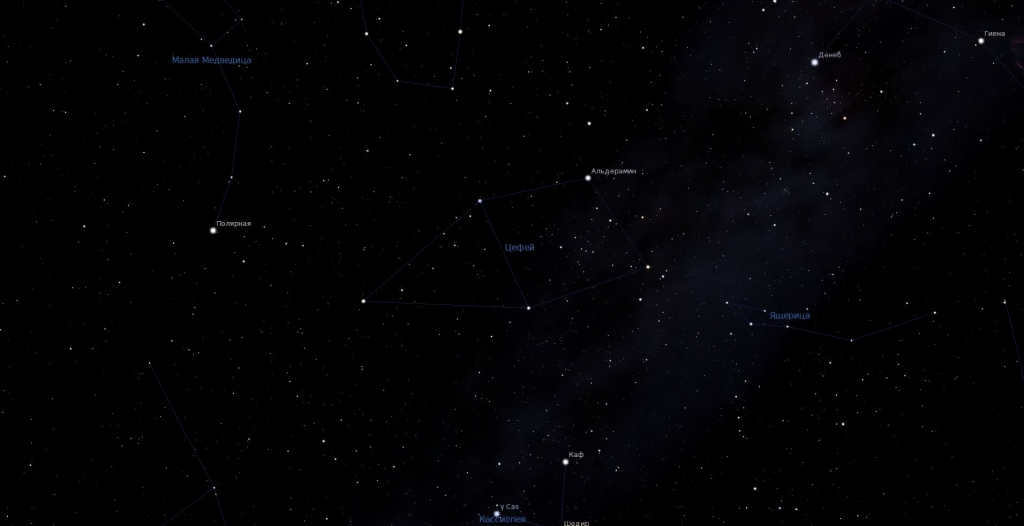
Cepheus, explore in the planetarium software
If you have some knowledge of the starry sky, you can easily locate the Cepheus constellation by navigating through its neighboring constellations: Ursa Minor, Cassiopeia, Lacerta, Draco, and Cygnus. This constellation doesn’t have many bright stars, with only eight of them having a magnitude greater than four. However, on a clear night without the moon, you can see at least 60 stars in Cepheus. The best time to observe it in the southern hemisphere is from July to September. However, since Cepheus is highly inclined to the north, it remains visible throughout the year in places like Russia.
This particular group of stars covers a relatively small area of 588 square degrees in the celestial sphere. It is worth noting that in the near future, the world’s north pole will shift towards the constellation Cepheus. This phenomenon can be attributed to the Earth’s axis undergoing precession, aligning it towards the direction of this specific constellation. Consequently, by the year 3100, the star known as gamma Cepheus (or Alrai) will be positioned near the pole. Following this, the star beta Cepheus (or Alfirk) will approach the north pole between the years 5100 and 6500. Lastly, by the year 8300, the star alpha Cepheus, also known as Alderamin, will assume the role of the polar star. Now, let us delve into the captivating world of the most intriguing stars within this constellation.
Upcoming North Star in the Cepheus Constellation
Shift of the North Pole of the Earth
As previously mentioned, due to the Earth’s axis precession, the star Alpha Cepheus will serve as the North Star in approximately 4000 years. This is quite remarkable considering that Alderamin, despite having a star magnitude of only 2.45m, is the brightest star in the Cepheus constellation. It can easily be observed with the naked eye, even in areas with excessive light pollution. Alderamin is located 49 light years away from our planet. The name of this celestial body, which translates to “right hand” in Arabic, adds to its beauty.
Alpha Cepheus
Alpha Cepheus, a star system located in the Cepheus constellation, is a fascinating celestial object. It is renowned for its prominence and exceptional characteristics. This system, also known as Alpha Cep, is a binary star system consisting of two stars, Alpha Cepheus A and Alpha Cepheus B. These stars are locked in a gravitational dance, orbiting around a common center of mass.
Alpha Cepheus A, the primary star of the system, is a blue-white supergiant. It is one of the most massive stars known, with a luminosity that surpasses that of our Sun. Its size is truly remarkable, with a radius over 50 times larger than the Sun. This massive star also emits a tremendous amount of energy, making it one of the brightest stars in the night sky.
On the other hand, Alpha Cepheus B is a smaller and cooler star. It is classified as a main-sequence star, meaning that it is in a stable phase of its life cycle, fusing hydrogen into helium in its core. Although not as massive or luminous as its companion, Alpha Cepheus B still contributes to the overall beauty and dynamics of the system.
The interaction between these two stars is an awe-inspiring sight. As they orbit each other, they create tidal forces that cause their shapes to distort. This phenomenon is known as tidal distortion, and it is a common characteristic of binary star systems. The gravitational pull of each star on the other also leads to periodic changes in their brightness, known as eclipses. These eclipses can provide valuable information about the stars’ properties and dynamics.
In addition to its binary nature, Alpha Cepheus is also a variable star. This means that its brightness fluctuates over time. The variability of Alpha Cepheus is due to pulsations in its outer layers. These pulsations cause the star’s radius and temperature to change, resulting in variations in its luminosity. Observing and studying these changes can provide valuable insights into the internal structure and evolution of massive stars.
Alpha Cepheus is not only a fascinating celestial object but also a significant star system for scientific research. Astronomers continue to study and explore this system, unraveling its mysteries and expanding our knowledge of stellar evolution and dynamics.
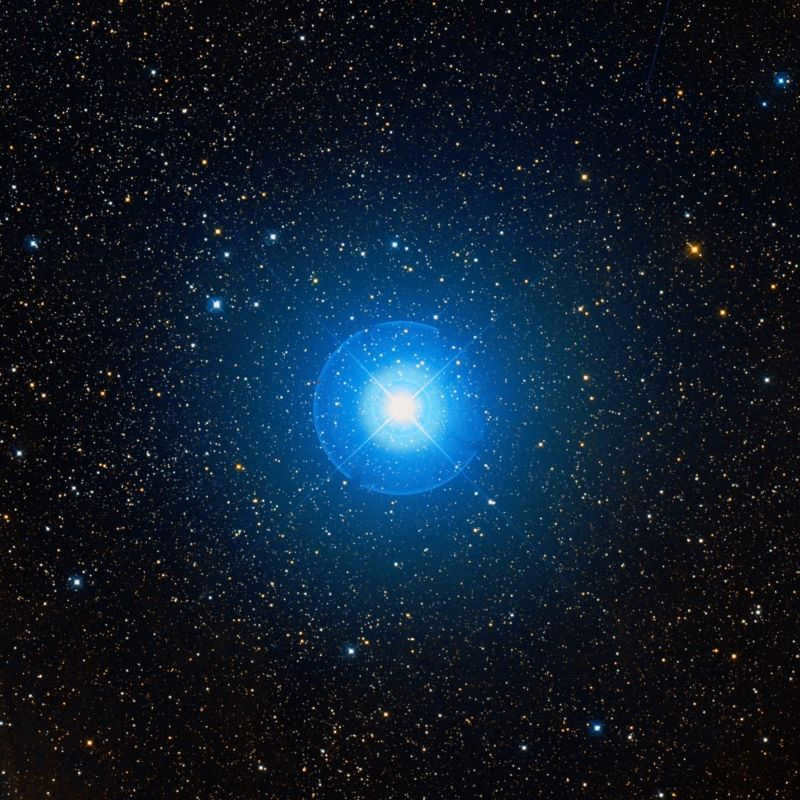
When it comes to the astronomical classifications of Alpha Cepheus, it’s important to note that it falls under the category of a typical white star belonging to spectral class A. Its luminosity level places it in the subgiant class. There are indications that Alderamin is undergoing a transformation into a red giant due to its hydrogen reserves being close to depletion. With the distance between Cepheus Alpha and Earth, as well as its surface temperature of 7500 K, we can make certain assumptions about its parameters. The star is estimated to have a radius equivalent to two and a half times that of our Sun, and a mass of 1.9 solar masses. Alderamin has a total luminosity approximately 19 times greater than that of the Sun. Similar to other stars in its class, Alpha Cepheus is also classified as a variable star.
The star’s rotation speed is remarkably high, clocking in at a minimum of 246 km/s. This equates to a complete revolution every 12 hours. This rapid rotation suggests a potential slowing down of the separation process for chemical elements within the star’s composition. For comparison, our Sun completes a full revolution in a month, yet both Alderamin and the Sun exhibit similar levels of X-ray radiation. Considering additional factors, it is reasonable to infer an elevated magnetic activity for Alpha Cepheus, which is quite uncommon for stars with such rapid rotation.
Cepheus delta is the originator of the Cepheid clan
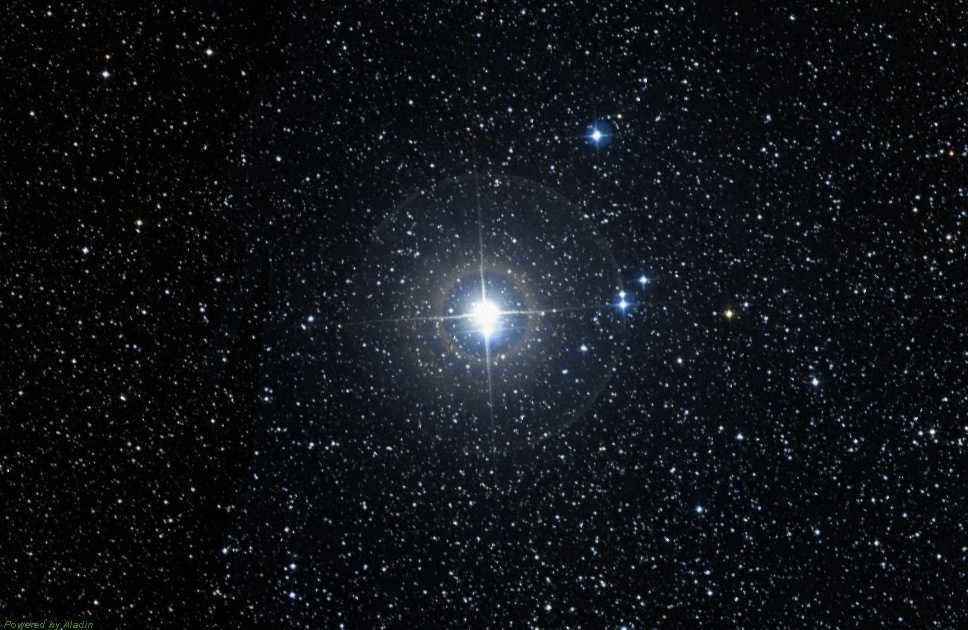
One other fascinating star located in this constellation is known as Delta Cepheus. The star is actually named Aldarif, a word derived from Arabic that means “next”. Delta Cepheus is classified as a binary star and is situated approximately 891 light-years away from our planet. The Aldarif star serves as the origin for an entire group of pulsating variable stars known as Cepheids. The variability of the Delta Cepheus Cepheid was first observed back in 1784 by a young scientist named Goodricke.
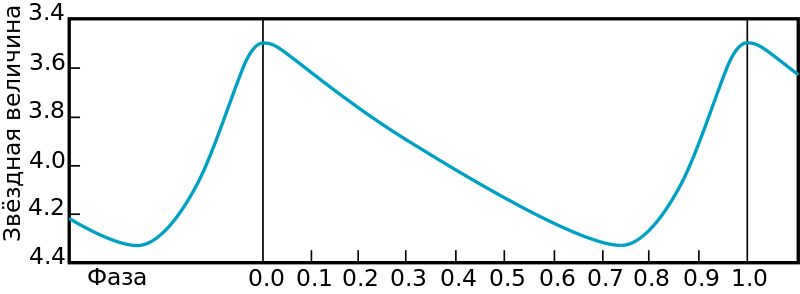
The light curve of the star δ Cepheus
Delta Cepheus, also known as Aldarif, is a star with a unique light curve. Its brightness changes with a period of 5 days and 9 hours, with the increase in luminosity happening much faster than its decline. At its brightest, Aldarif reaches a maximum stellar magnitude of 3.5m, while at its dimmest, it is at 4.4m. What makes this star even more intriguing is its spectrum. During the minimum light phase, delta Cepheus exhibits characteristics of a typical G2 star, similar to the Sun. However, during the maximum light phase, it transforms into a luminary of class F5. This phenomenon might suggest that Aldarif is a binary star system, but its light curve does not resemble that of spectrally double stars.
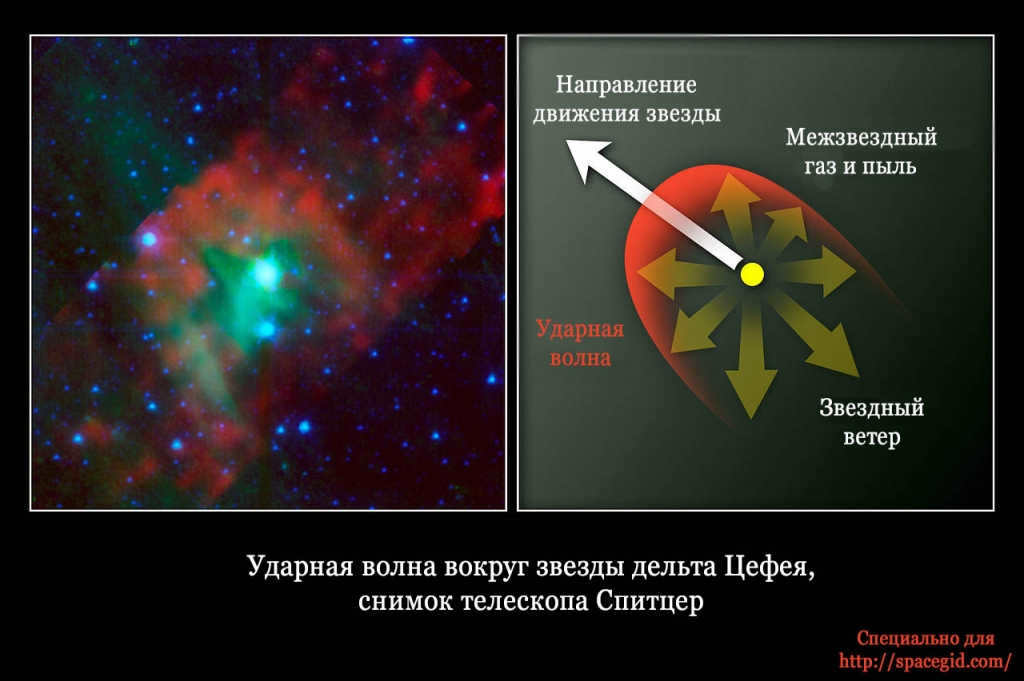
A shock wave emanating from the celestial body known as Cepheus delta has been discovered by a team of scientists.
Researchers have unearthed a key insight into the peculiar behavior of this star: it undergoes a cyclical process of pulsation, wherein it contracts and expands, resulting in a dramatic alteration of its diameter spanning millions of kilometers. Its radius, which is approximately equivalent to 40 times that of the Sun, experiences a shift to four solar radii during each pulsation. As Aldarif contracts, it experiences a rise in temperature, prompting a transformation in its spectral characteristics. Despite the reduction in its radiation-emitting surface area, the star begins to emit light that is significantly brighter. Conversely, during the expansion phase, Delta Cepheus exhibits an opposing pattern of behavior. Aldarif-type stars typically possess masses ranging from 3 to 30 times that of the Sun and have largely transitioned beyond the main sequence of stellar evolution.
Delta Cepheus B
can be rephrased as “B of Delta Cepheus” or “Cepheus Delta’s second component”.
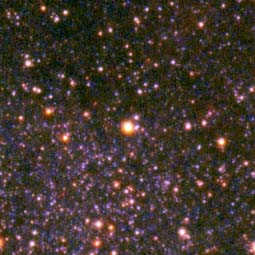
The second star accompanying Aldarif is known as Delta Cepheus B. It has a magnitude of 7.5m. Delta Cepheus B is positioned at a distance of twelve thousand astronomical units from the primary star.
This companion star has an orbital period of approximately 500 years. Even with a small telescope, it is possible to observe this star in the night sky.
Mu Cepheus – the star with immense power

Comparing the sizes of μ Cepheus and the Sun
The following star does not have a widely recognized “popular” name except for being designated as part of a constellation, namely Mu Cepheus. It is often referred to as Herschel’s Garnet Star, named after the scientist William Herschel, who noted its vibrant color. This star is classified as a red supergiant. It is among the largest and most powerful stars in the Milky Way, with a luminosity that is 350,000 times that of the Sun. The spectral class of Mu Cepheus is defined as M2Ia.
Characteristics of Mu Cepheus
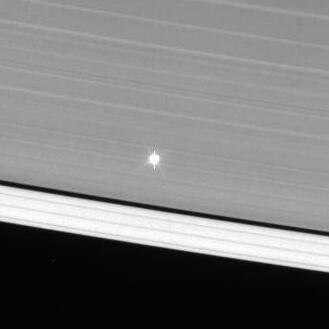

The star Mu Cepheus can be observed when looking through Saturn’s rings, as shown in the Cassini image taken on July 3, 2013.
Mu Cepheus is a member of a triple star system. Apart from the main star, two other components can be identified in this system: mu Cepheus B, which has an apparent magnitude of 12.3m, and mu Cepheus C, with a stellar magnitude of 12.7m. It is noteworthy that this star is currently in its final stage of evolution.
The process of burning helium has already commenced, leading to its transformation into carbon, providing undeniable proof of its imminent demise. It is highly probable that within the next several million years, it will undergo a catastrophic explosion, resulting in the formation of a supernova star, and potentially giving rise to a massive black hole from its core.
Hypergiant within the Cepheus constellation
As you may have already noticed, the composition of stars within the Cepheus constellation is truly remarkable. Another fascinating aspect of this constellation is the star VV Cepheus – a binary star system that undergoes eclipses, and is situated a mere 5000 light years away from our planet. In fact, its A component boasts the third largest radius and the second largest size in the entire Galaxy!
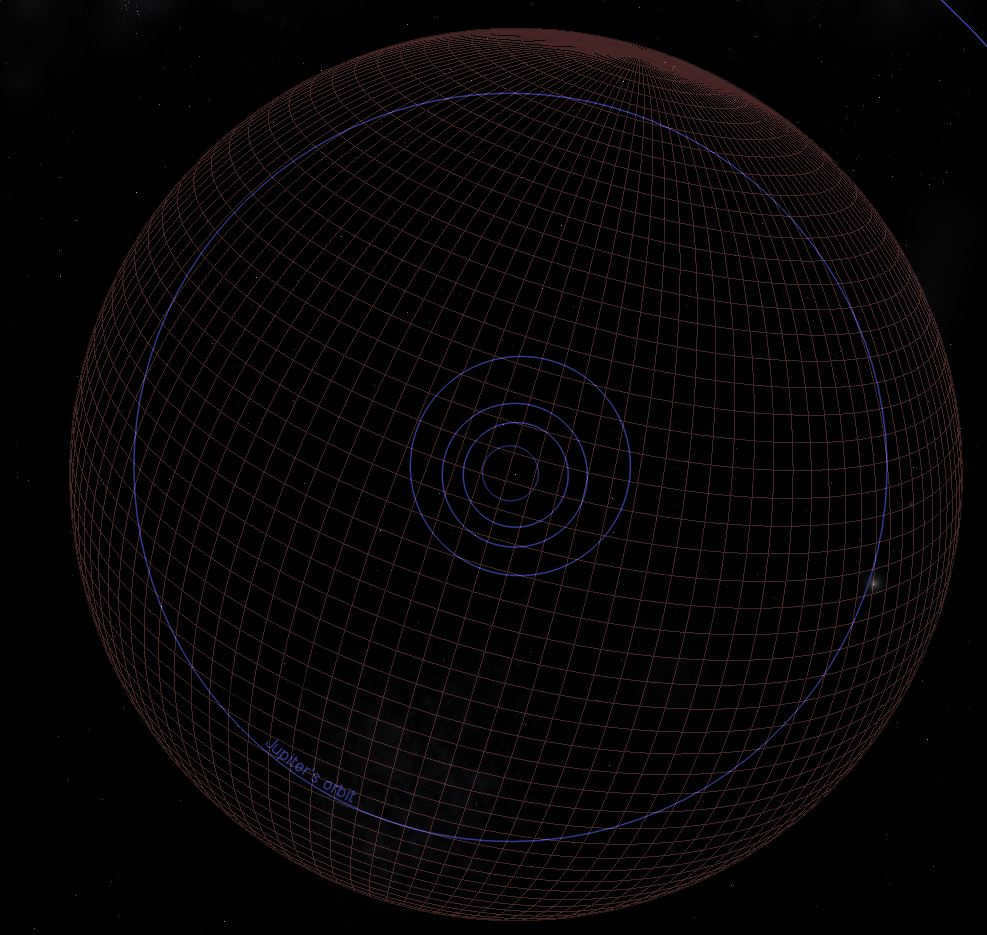
VV Cepheus A has a comparison to Jupiter’s orbit.
Therefore, VV Cepheus A is a rare red hypergiant, belonging to the M2 spectral class. Within the galaxy, it is the second largest star, with only the giant VY in the constellation of Canis Major surpassing it. Its diameter is approximately 1800 times larger than that of the Sun, on average, and its luminosity ranges from 275,000 to 575,000 times that of the Sun. Component A of VV Cepheus A has been confirmed to be a variable star that pulsates with a period of 150 days. By estimating its orbital motion, we can determine that its mass is around one hundred times that of the Sun, although considering its luminosity, it can only be estimated to be between 25-40 solar masses.
VV Cepheus B: A Unique Celestial Object
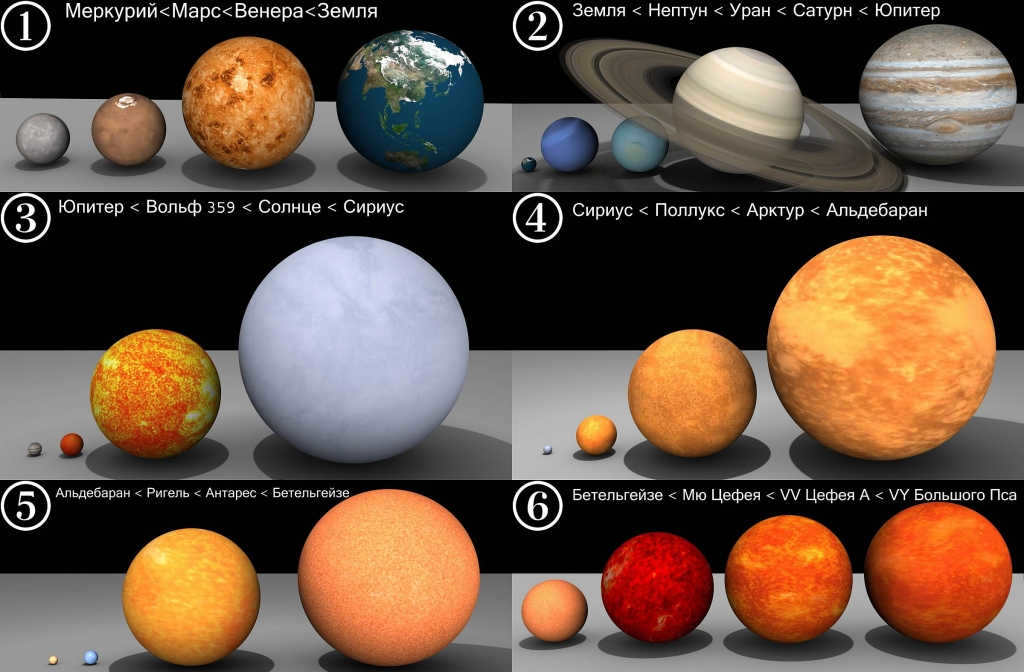
VV Cepheus B, the second component of the star being discussed, was found in 1936 to not only be a binary star, but also an eclipsing variable. Since then, eclipses of the B component have been observed every 20 years. This star is classified as a blue main sequence star in spectral class B0. It revolves around the A component in an elliptical orbit. The complete orbit takes approximately 7430 days, or about twenty years. The eclipse of component A by component B lasts approximately 3.6 years. VV Cepheus B has a diameter about ten times larger than that of the Sun, and its luminosity is one hundred thousand times greater. The distance between the two components of VV Cepheus varies from 17 to 34 astronomical units.
Kruger 60 is not portrayed as a villain, but rather as a celestial body within the constellation Cepheus
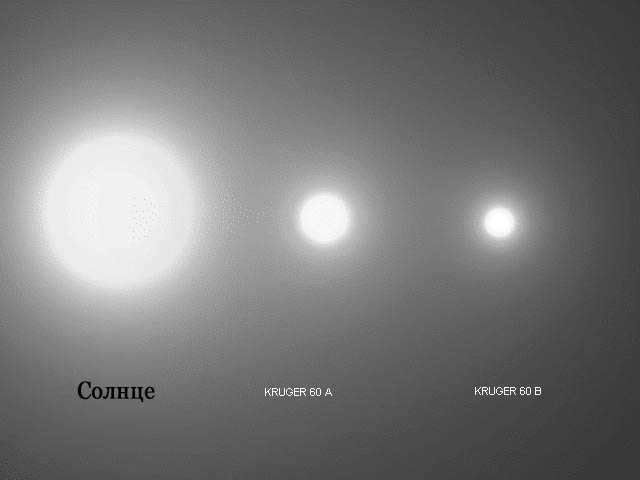
Comparison of the sizes of Kruger 60 A and B stars and the Sun
Another fascinating star in the same constellation is Kruger 60 or DO Cepheus. It consists of two red dwarf stars located thirteen light years away from the Sun. These stars revolve around a common center of mass. It takes them about 45 years to complete one orbit. The larger star in the Kruger 60 system is referred to as A, while the smaller one is known as B. Kruger B is classified as a flaring star, meaning it periodically emits bursts of increased brightness. These flares occur every 8 minutes. During a flare, Kruger B shines twice as brightly as usual before returning to its normal state.
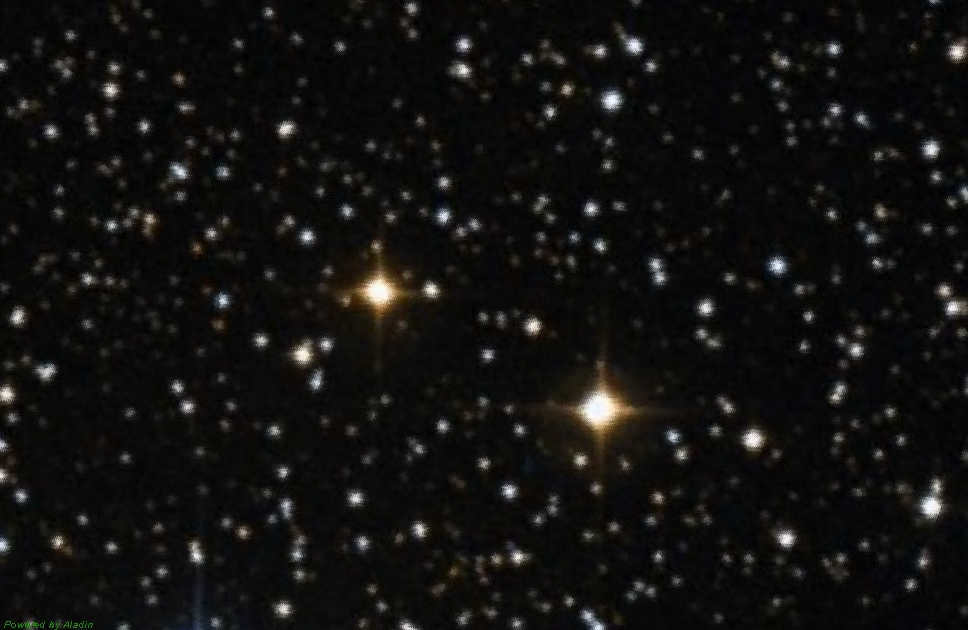
Photograph depicting the stars Kruger 60 A and B
The parameters of the Kruger 60 star components are as follows: component A has a mass equivalent to approximately 27% of the mass of the Sun, and a radius equivalent to approximately 35% of the radius of the Sun. On the other hand, component B has a mass equivalent to approximately 18% of the mass of the Sun and a radius equivalent to approximately 24% of the radius of the Sun. The average distance between Kruger A and Kruger B is 9.5 astronomical units, which is roughly the same distance that separates Saturn from the Sun. However, the orbit of the Kruger 60 star exhibits some eccentricity, meaning that the mentioned distance may vary between 5.5 and 13.5 astronomical units.
Other notable attractions in the Cepheus constellation
Exploring the NGC 188 dispersed star cluster
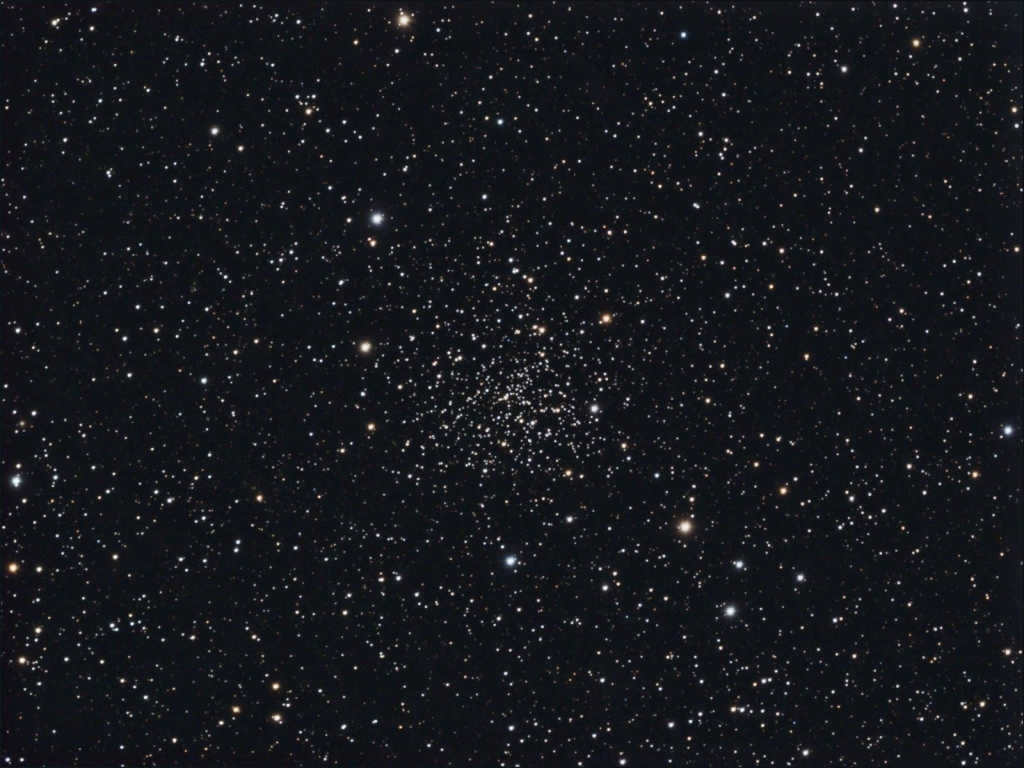
In addition to the astonishing celestial bodies, Cepheus boasts a plethora of other fascinating astronomical entities. Particularly noteworthy is the dispersed assemblage known as NGC 188. It is a rare gem in the cosmos, being one of the oldest clusters with an estimated age of at least 5 billion years. This cluster is comprised of approximately 120 stars located a staggering six thousand light years away from our position.
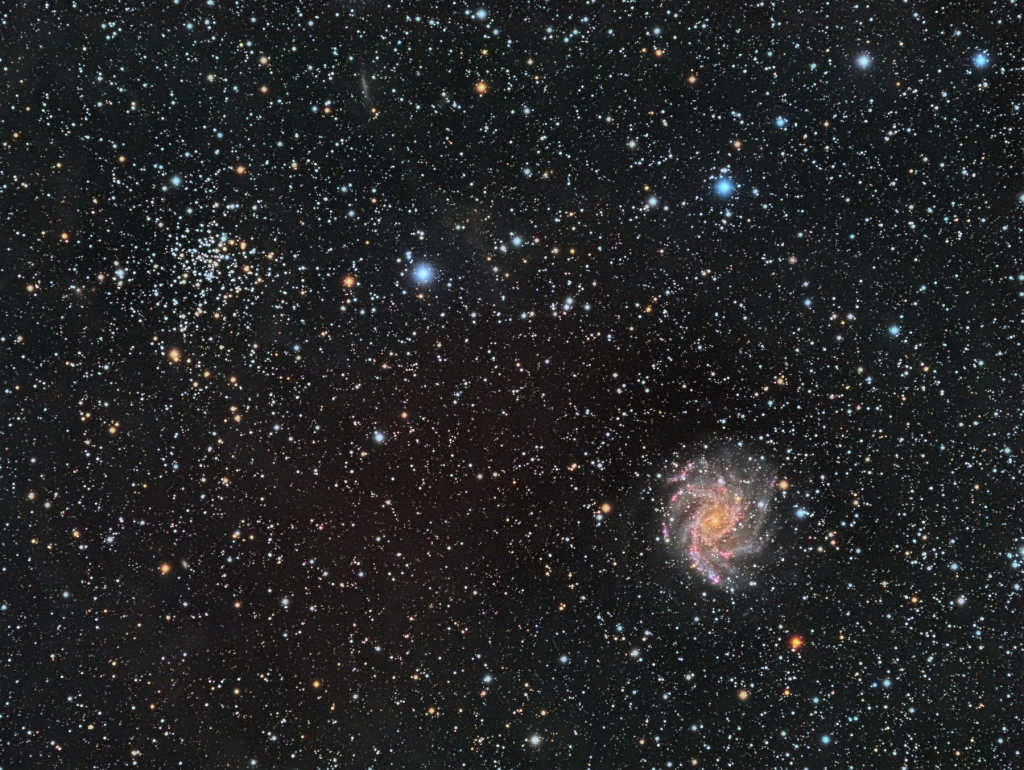
NGC 6946 is a captivating spiral galaxy that features a distinctive junction. Positioned to the left and above, you can observe the presence of a dispersed star cluster known as NGC 6939.
NGC 6946, also referred to as Fireworks, is not only a source of fascination for astronomers but also for ordinary individuals. Being located 22 million light years away from us, this galaxy was initially discovered by the renowned scientist Herschel in 1768. What makes this spiral galaxy truly exceptional is the fact that it has witnessed the occurrence of an astounding 9 supernovae, which is significantly more than any other galaxy!
Historical Background
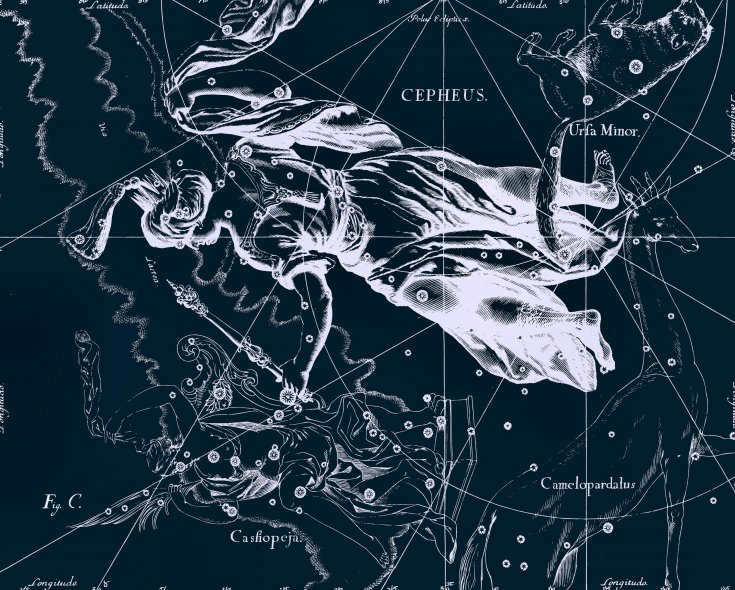
Jan Hevelius created a drawing of the constellation Cepheus for his atlas of constellations.
When discussing the history of the Cepheus constellation, it is important to consider its connection to Greek mythology, which also involves the constellations of Andromeda, Cassiopeia, and Perseus. The constellation is believed to be based on the Ethiopian king Cepheus, who was married to Cassiopeia and the father of Andromeda. In the myth, Cepheus’ daughter was saved by Perseus from a monster.
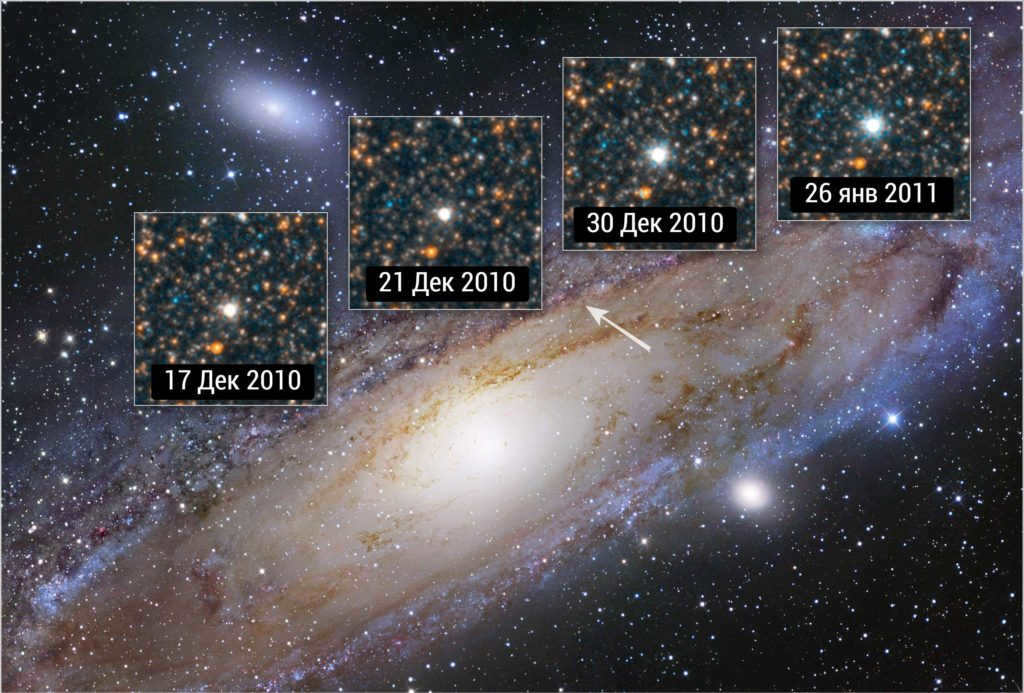
Where can they be located
Our Galaxy currently contains several hundred cepheids, while other galaxies have several thousand more. The discovery of cepheids has greatly aided astronomers in determining the distances to other galaxies. Cepheids are often referred to as the guiding lights of the Universe. These stars are relatively young and are primarily concentrated in the plane of our Galaxy, where they can be found in various star clusters. On the other hand, the majority of another type of pulsating variable stars, such as RR Lyrae stars, are among the oldest stars in existence. While they are not heavily concentrated in the galactic plane, these stars are abundant in the direction towards the center of our Galaxy and can be found in certain globular star clusters, which are the oldest known formations in our Galaxy (with an age exceeding 10 billion years).
Reasons for the fluctuation in luminosity
The fluctuation in luminosity of Cepheids is caused by radial pulsations. The atmospheres of Cepheids expand and contract, resulting in temperature changes. When the atmosphere contracts, it becomes hotter, and when it expands, it cools down. The Cepheid appears brightest when it is relatively small yet hot. The pulsations of Cepheids are not only evident in changes in brightness but also in variations in radial velocity. By observing the radial velocities of Cepheids, we can determine that they fluctuate in the same period as the luminosity. This indicates that the star is pulsating, and we can observe how the velocities of different atmospheric layers change in relation to the observer on Earth.
How valuable is it?
By analyzing the fluctuation in brightness and radial velocity of a Cepheid star, scientists can accurately determine its size and how it changes during pulsations. Researchers have also established a correlation between the period of variability and the luminosity of Cepheids: the longer the period, the greater the amount of energy the star emits into space over time. By using the period-luminosity relationship to calculate the power of radiation, scientists can calculate the distance to the Cepheid star, as well as the distance to any star system it may belong to, such as a star cluster or galaxy.
The age of a Cepheid can be determined by knowing its period. In the 1960s, Soviet astronomer YN Efremov discovered that the younger the Cepheid, the longer its period. However, it is important to note that the luminosity of pulsating variable stars does not change strictly in a periodic manner. Even stars like Keith’s Worlds, which exhibit relatively regular behavior, do not exactly replicate the shape of their light curve and the duration between maximum points from one cycle to the next.
The cosmos is an immensely vast realm. Specifically, it extends 46 billion light years in every direction from our vantage point! However, it’s important to note that this is merely the observable portion, leading scientists to believe that it is even more expansive.
To comprehend this, one must possess the ability to gauge such distances. Astronomy is a constantly evolving field, always seeking innovative methodologies. In addition to analyzing redshift and studying light, researchers also rely on a category of stellar celestial entities known as variable Cepheids.
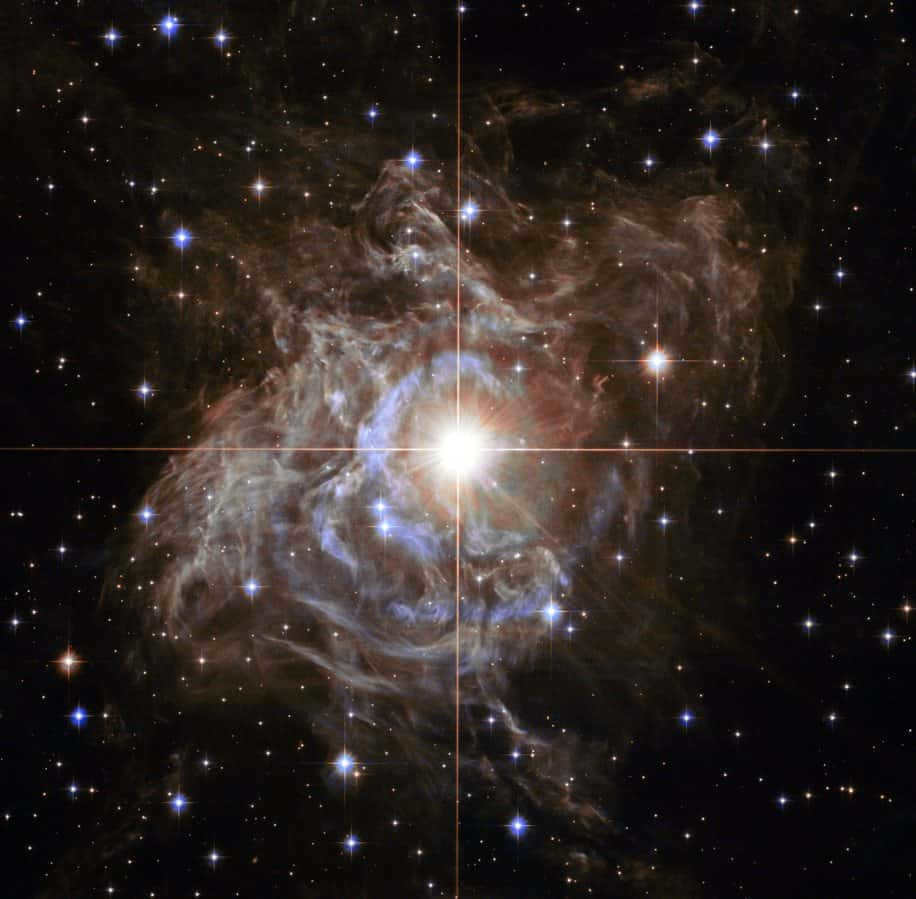
Hubble has captured an image of the variable star RS Korma.
Variable stars, such as Cepheids, are stars that experience fluctuations in their brightness. These Cepheids have a mass that ranges from 5 to 20 times that of the Sun. What sets them apart is their radial pulsations, which cause changes in their diameter and temperature.
One fascinating aspect of these pulsations is that they are directly related to the star’s absolute brightness, which varies in specific periods ranging from 1 to 100 days. When plotted on a graph, the resulting light curve resembles the shape of a shark’s fin – a sudden peak followed by a decline.
This class of stars was named after the Delta Cepheus stars. Spectral analysis has revealed temperature variations ranging from 5500 K to 6600 K, as well as diameter variations of approximately 15%.
Utilization of Cepheids in the field of astronomy
The Cepheids possess the potential to be regarded as guiding lights within the vast expanse of the Universe. The relationship between the oscillation period and luminosity proves to be exceedingly valuable when it comes to the computation of distances between celestial bodies. In order to carry out this task, the subsequent equation is employed: m – M = 5 log d – 5. In this equation, m represents the apparent magnitude (luminosity), M signifies the absolute magnitude, and d denotes the distance to the celestial object in parsecs. The variable Cepheids can be observed and gauged from a distance of 20 million light years.
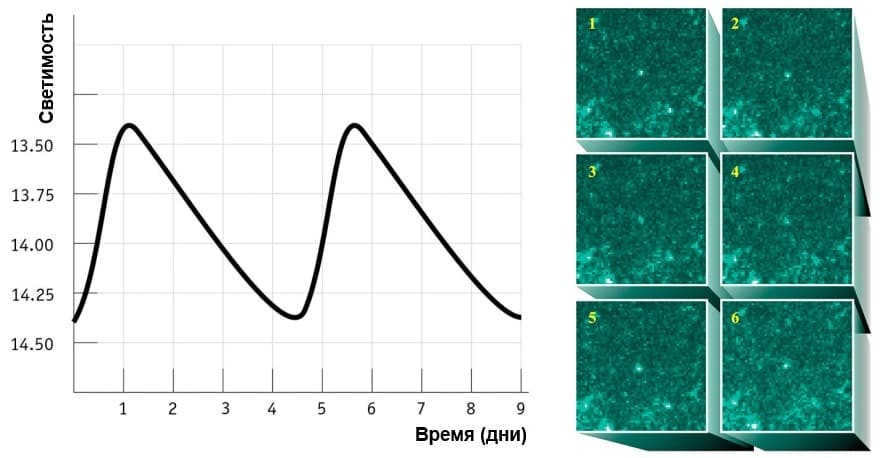
The ratio of the period to the luminosity of Cepheids can be used to track nearby objects due to their brightness and visibility. By considering the correlation between the period and the brightness, we can utilize Cepheids as a valuable tool for determining the scale of the Universe.
Types of Cepheids
There are two primary categories of Cepheids: classical and type II Cepheids. Classical Cepheids belong to the population I (metal-rich) group and have a mass that is 4-20 times greater than that of the Sun. They are also 100,000 times brighter. These Cepheids have a regular pulsation pattern that lasts for days or months.
Classical Cepheids are yellow bright giants or supergiants (F6-K2) that experience variations in radius by millions of kilometers during the pulsation process. They are commonly used to measure distances to galaxies both within and beyond the Local Group.
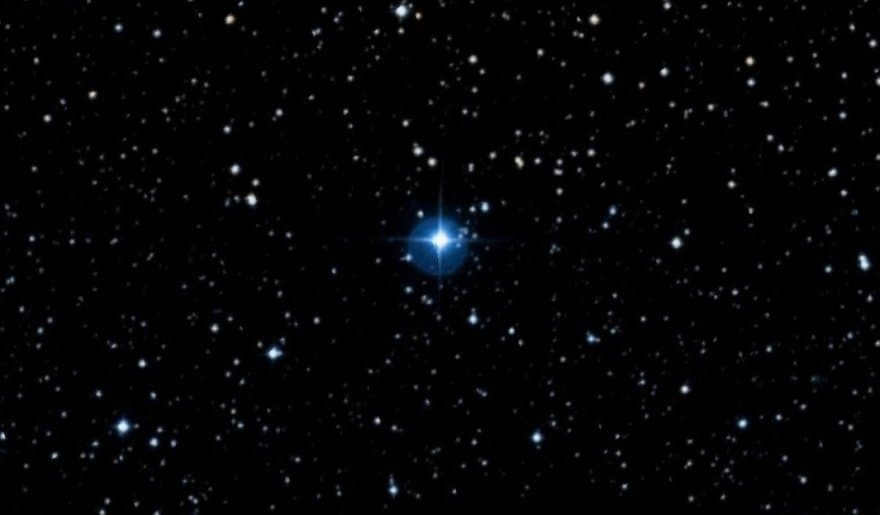
Type II Cepheids are characterized by their low metal content. They have a pulsation period that ranges from 1 to 50 days. These stars are approximately 10 billion years old and have a mass that is about half that of the Sun. They can be further classified into subgroups based on their pulsation periods, such as BL Hercules (1-4 days), W Virgo (10-20 days), and RV Taurus (more than 20 days). Type II Cepheids are commonly used in astronomical calculations involving the distance to the galactic center, globular clusters, and nearby galaxies.
Anomalous Cepheids, on the other hand, have a period of 2 days (similar to RR Lyra), but they are much brighter. They have a higher mass compared to Type II Cepheids, but their age is still unknown. There is also a small percentage of variables that pulsate in two different modes simultaneously, known as “dual-mode Cepheids”.
Cepheid discoveries
In the annals of astronomy, the discovery of Cepheid variable stars holds a significant place. The first recorded observation of such a star was made by Edward Pigott on September 10, 1784. He chanced upon Eta Eagle, a remarkable celestial object that would go on to captivate astronomers for centuries to come. Not long after, on a fateful day, John Goodrick stumbled upon Delta Cepheus, another Cepheid star that added to the growing body of knowledge.
Fast forward to 1908, when the exploration of variable stars took astronomers to the Magellanic Clouds. It was during this time that Henrietta Leavitt made a breakthrough discovery. She found a crucial relationship between the period and brightness of classical Cepheids, a finding that would revolutionize our understanding of these enigmatic stars. In 1912, Leavitt published her meticulous records, which included the periods of 25 variable stars, cementing her place in history as a pioneering astronomer.
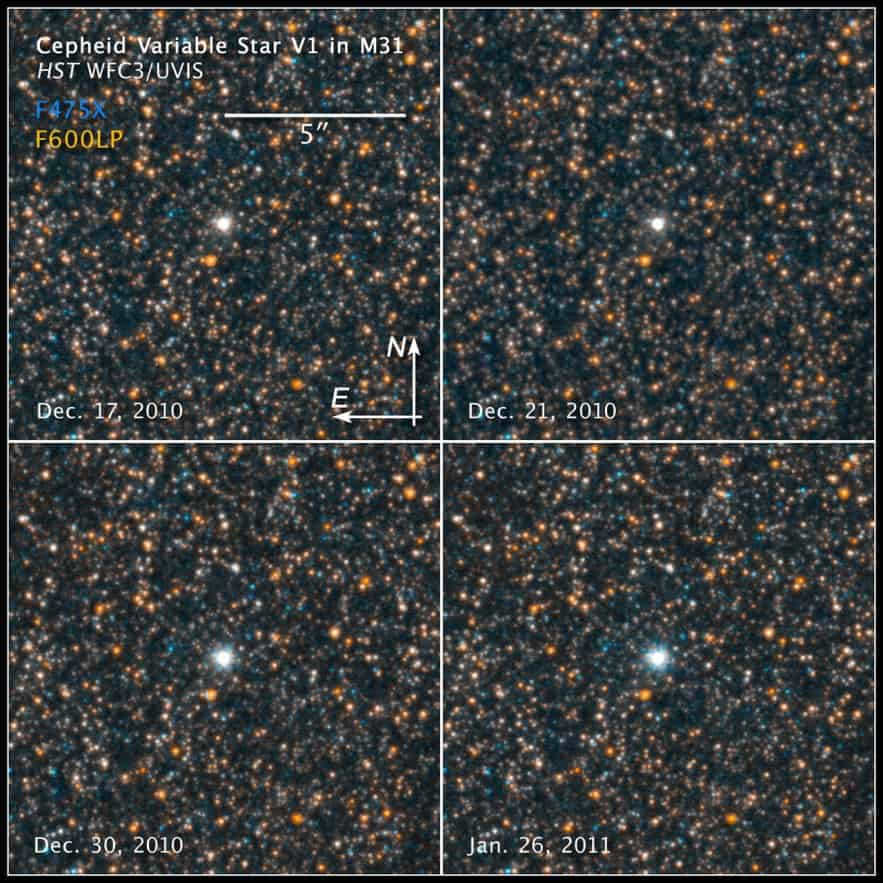
The fluctuating brightness of Cepheid V1 in Messier 31
In 1925, Edwin Hubble made a groundbreaking discovery by determining the distance between the Milky Way galaxy and Andromeda. This was a significant achievement as it challenged the prevailing belief that our galaxy was the only one in existence. By measuring the distances between various galaxies, including the Milky Way, and analyzing the redshift of Vesto Slifer, Hubble and Milton Humason were able to establish Hubble’s Law, which confirmed the expanding nature of the universe.
During the 20th century, scientists focused on categorizing Cepheids and developing formulas to calculate distance. Walter Baade played a crucial role in this endeavor, as he distinguished between classical Cepheids and Type II Cepheids based on their size, luminosity, and age, providing valuable insights into their nature.

